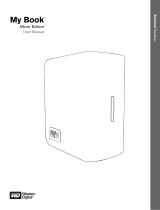
LaCie 4big Quadra • Design by Neil Poulton Foreword
User Manual page 2
Copyrights
Copyright © 2008 LaCie. All rights re-
served. No part of this publication may
be reproduced, stored in a retrieval sys-
tem, or transmitted in any form or by any
means, electronic, mechanical, photo-
copying, recording or otherwise, without
the prior written consent of LaCie.
Trademarks
Apple, Mac, and Macintosh are reg-
istered trademarks of Apple Inc. Mi-
crosoft, Windows 98, Windows 98 SE,
Windows 2000, Windows Millennium
Edition, Windows XP and Windows Vista
are registered trademarks of Microsoft
Corporation. Other trademarks men-
tioned in this manual are the property of
their respective owners.
Changes
The material in this document is for in-
formation only and subject to change
without notice. While reasonable efforts
have been made in the preparation of
this document to assure its accuracy,
LaCie assumes no liability resulting from
errors or omissions in this document,
or from the use of the information con-
tained herein. LaCie reserves the right to
make changes or revisions in the prod-
uct design or the product manual with-
out reservation and without obligation to
notify any person of such revisions and
changes.
Canada Compliance Statement
This Class B digital apparatus meets all
requirements of the Canadian Interfer-
ence-Causing Equipment Regulations.
Japan Compliance Statement
This is a Class B product based on the
standard of the Voluntary Control Coun-
cil for Interference from Information
Technology Equipment (VCCI). If this is
used near a radio or television receiver
in a domestic environment, it may cause
radio interference. Install and use the
equipment according to the instruction
manual.
FCC Statement
This device complies with Part 15 of the
FCC Rules. Operation is subject to the
following conditions:
1. The devices may not cause harmful
interference
2. The devices must accept any inter-
ference received, including inter-
ference that may cause undesired
operation.
NOTE: This equipment has been tested
and found to comply with the limits for a
Class B digital device, pursuant to Part
15 of the FCC Rules. These limits are
designed to provide reasonable protec-
tion against harmful interference in a
residential installation. This equipment
generates, uses and can radiate radio
frequency energy and, if not installed and
used in accordance with the instructions,
may cause harmful interference to radio
communications. However, there is no
guarantee that interference will not occur
in a particular installation. If this equip-
ment does cause harmful interference to
radio or television reception, which can
be determined by turning the equipment
off and on, the user is encouraged to try
and correct the interference by one or
more of the following measures:
✦ Reorient or relocate the receiving
antenna.
✦ Increase the separation between
the equipment and receiver.
✦ Connect the equipment into an out-
let on a circuit different from that to
which the receiver is connected.
✦ Consult the dealer or an experi-
enced radio/TV technician for help.
Modifications to this product not autho-
rized by LaCie could void the FCC &
Industry Canada regulations and negate
your authority to operate the product.
Manufacturer’s Decla-
ration for CE Certifica-
tion
We, LaCie, solemnly declare that this
product conforms to the following Eu-
ropean standards: Class B EN60950,
EN55022, EN55024, EN61000-3-2:
2000, EN61000-3-3: 2001
With reference to the following condi-
tions: 73/23/EEC Low Voltage Direc-
tive; 89/336/EEC EMC Directive
This symbol on the product
or on its packaging indi-
cates that this product must
not be disposed of with
your other household
waste. Instead, it is your responsibility to
dispose of your waste equipment by
handing it over to a designed collection
point for the recycling of waste electrical
and electronic equipment. The separate
collection and recycling of your waste
equipment at the time of disposal will
help to conserve natural resources and
ensure that it is recycled in a manner that
protects human health and the environ-
ment. For more information about where
you can drop off your waste equipment
for recycling, please contact your local
city office, your household waste dispos-
al service, or the shop where you pur-
chased the product.
CAUTION: Modifications not autho-
rized by the manufacturer may void the
user’s authority to operate this device.
CAUTION: A shielded-type power
cord is required in order to meet FCC
emission limits and also to prevent in-
terference to the nearby radio and tele-
vision reception. It is essential that only
the supplied power cord be used.
Tested to comply with FCC
standards for home or office
use
LaCie 4big Quadra






















